Tom's Hardware Verdict
The Cooler Master GM27-FQS delivers excellent image quality and gaming performance at a reasonable price. It supports HDR though the picture doesn’t look much different than its SDR counterpart. With unique styling and a solid build, it’s a good match for mid-priced gaming systems.
Pros
- +
Accurate color with little adjustment needed
- +
Excellent video processing
- +
Unique lighting feature and styling
- +
Good value
Cons
- -
No extra contrast in HDR mode
Why you can trust Tom's Hardware
The QHD 165 Hz category is filled with capable gaming monitors that deliver a lot of performance for the money. They represent the sweet spot of value and performance with snappy response, smooth motion and high frame rates. And with fewer pixels to move around than an Ultra HD screen, they don’t require a high-end video card to drive them to their full potential.
Cooler Master is a bit off the beaten path when it comes to display brands, but their monitors have proven capable with solid build quality, color accuracy and high performance. I’ll be looking at its latest 27-inch QHD screen – the GM27-FQS. It runs at 165 Hz with Adaptive-Sync, HDR10 and extended color. It also offers selectable color gamuts (a rarity) and a slick lighting feature that stands out from the competition among the best gaming monitors.
Cooler Master GM27-FQS Specs
| Panel Type / Backlight | IPS / W-LED, edge array |
| Screen Size / Aspect Ratio | 27 inches / 16:9 |
| Max Resolution & Refresh Rate | 2560x1440 @ 165 Hz |
| Row 3 - Cell 0 | FreeSync: 48-165 Hz |
| Row 4 - Cell 0 | G-Sync Compatible |
| Native Color Depth & Gamut | 8-bit / DCI-P3 |
| Response Time (MPRT) | 1ms |
| Brightness (mfr) | 300 nits |
| Contrast (mfr) | 1,000:1 |
| Speakers | None |
| Video Inputs | 1x DisplayPort 1.2 |
| Row 11 - Cell 0 | 2x HDMI 2.0 |
| Row 12 - Cell 0 | 1x USB-C |
| Audio | 3.5mm headphone output |
| USB 3.0 | 1x up, 2x down |
| Power Consumption | 29.7w, brightness @ 200 nits |
| Panel Dimensions WxHxD w/base | 24.2 x 18.8-23.2 x 10.8 inches (615 x 478-588 x 274mm) |
| Panel Thickness | Upper: 0.3 inch (7 mm) |
| Row 18 - Cell 0 | Lower: 1.7 inches (43 mm) |
| Bezel Width | Top/sides: 0.3 inch (7 mm) |
| Row 20 - Cell 0 | Bottom: 0.5 inch (13 mm) |
| Weight | 11.24 pounds (5.1 kg) |
| Warranty | 3 years |
The GM27-FQS starts with a quick IPS panel capable of a 1ms MPRT response time. Adaptive-Sync works on both FreeSync and G-Sync platforms over a 48-165 Hz range. This monitor has not been certified by Nvidia, but I saw no issues during testing with either Radeon or GeForce video cards. It also includes a backlight strobe option for blur reduction that works instead of Adaptive-Sync.
Image quality is assured by a wide color gamut that covers just under 92% of DCI-P3, according to my measurements. That puts it slightly above average for the category and adds to the value factor. Color is very accurate as well. I discovered that calibration is completely unnecessary. Even when I tried a few tweaks, I could not make the picture any better. I also found selectable color gamuts for all the major standards from sRGB to Rec.2020. Their performance varies a bit; I’ll show you more about that on page four.
The GM27-FQS has unique styling elements starting with a panel with an upper portion that is just seven millimeters thick. There’s a component bulge at the bottom, but this particular aesthetic more often seen in OLED displays.
The LED lighting feature is something I haven’t seen before. Cooler Master calls it the Halo Stand, and it indeed looks like a halo. A soft glow of multiple colors emanates from the base which is shaped like the Cooler Master logo. Its effects can be controlled with a desktop app.
The GM27-FQS looks to be a very capable gaming monitor equally adept at work or play. At $410 at this writing, it looks like a good value as well. Let’s take a look.
Get Tom's Hardware's best news and in-depth reviews, straight to your inbox.
Assembly & Accessories
The GM27-FQS comes well-protected in a carton filled with crumbly foam. The base attaches to the upright with a captive bolt. Find the four fasteners and the included Phillips-head screwdriver to mate the panel to the stand. Once complete, the package is fairly light in weight but rock solid. Bundled accessories include an external power supply, USB-C lighting cable for the base, DisplayPort and HDMI.
Product 360
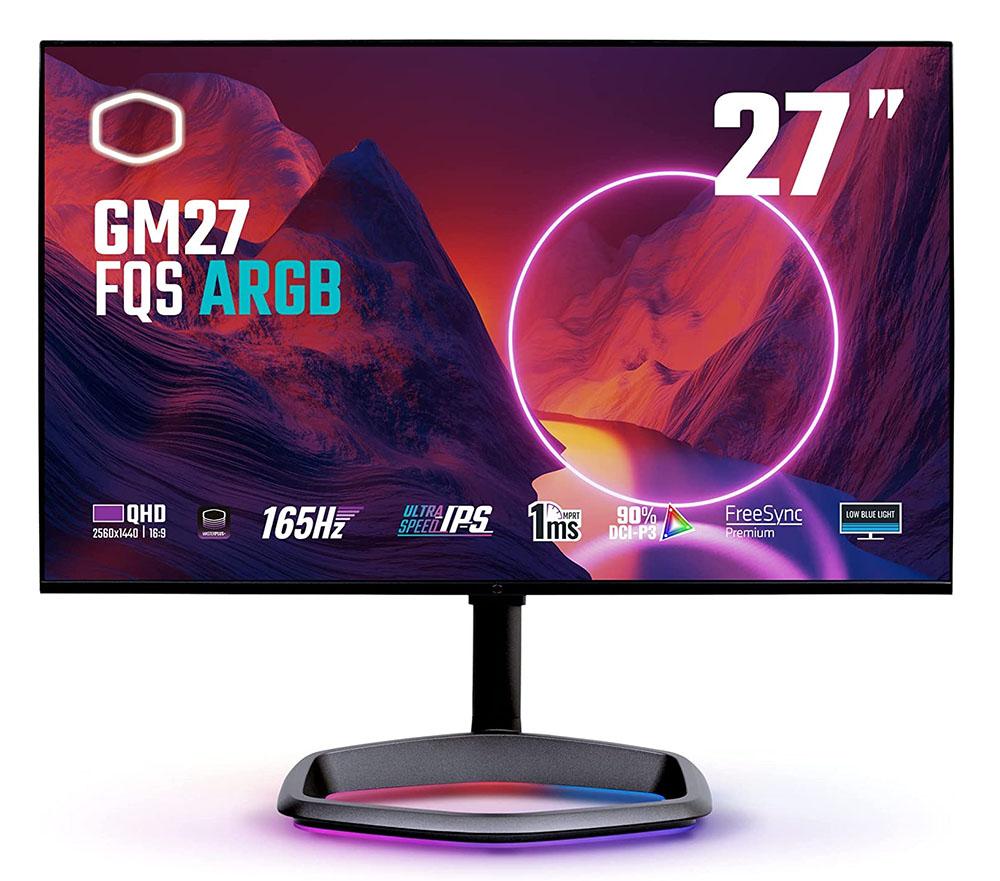
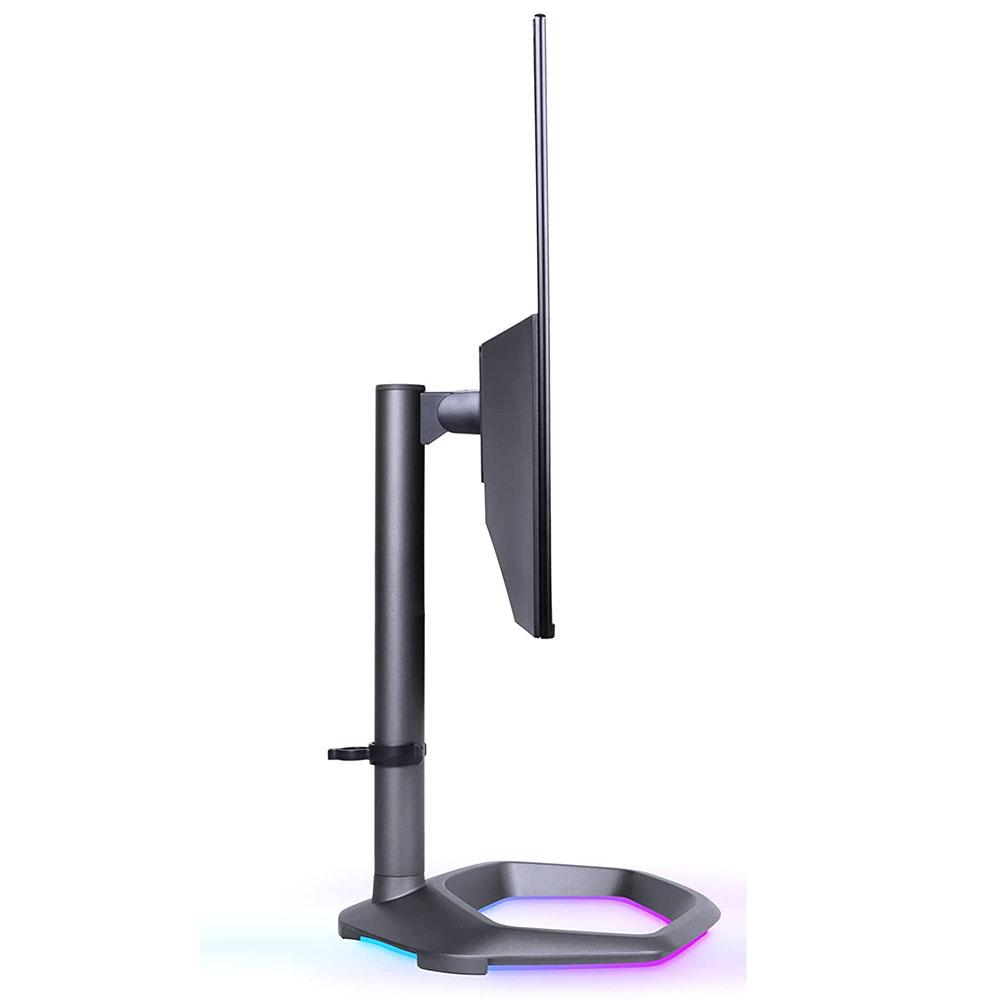
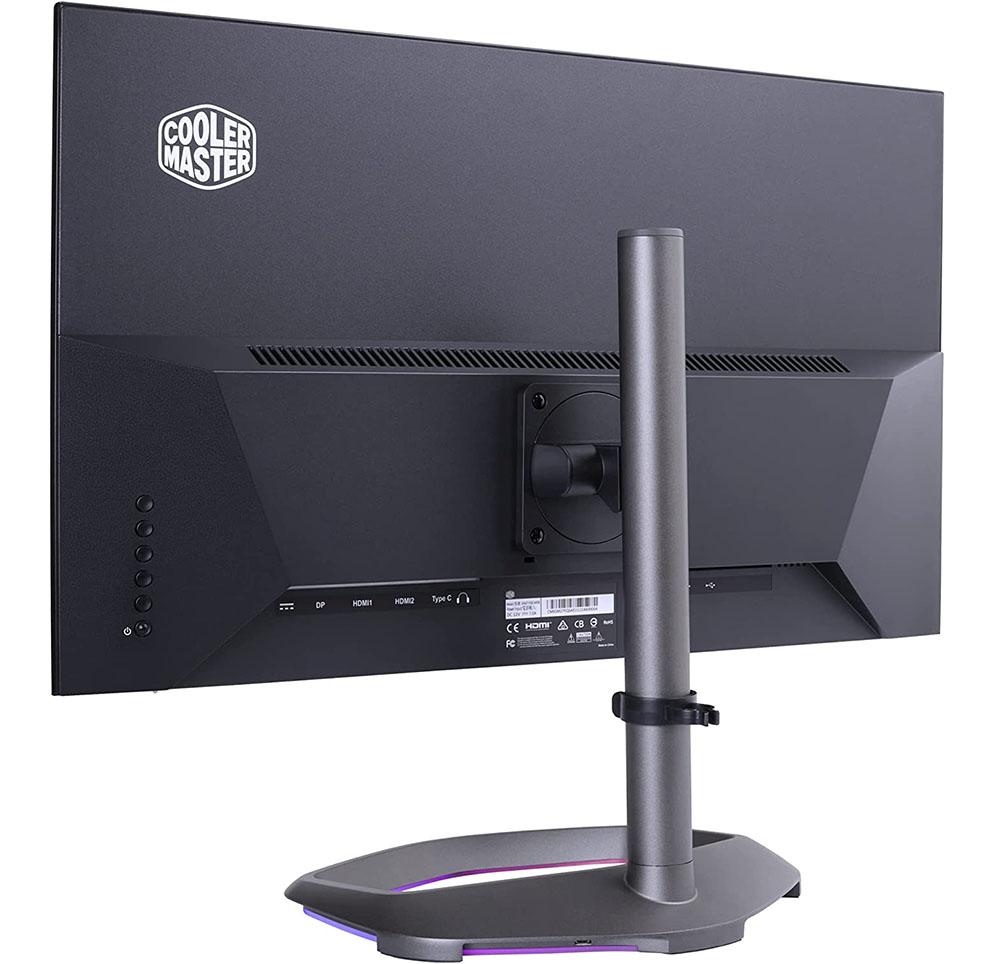

The GM27-FQS is all about appearing thin. The upper portion of the panel is very slim, just 7 mm thick. The bezel is also 7 mm wide and flush around the top and sides. The bottom trim is a little wider at 13 mm, but it too is barely there. Only a minuscule Cooler Master logo is molded into it. The screen’s anti-glare layer is similar to what’s found on nearly every computer monitor and provides a sharp and grain-free image with no glare.
The Halo LED comes from the base, where you’ll see an opaque diffusion cover that emits a rainbow of colors. There aren’t any controls for it in the OSD, but if you download the MasterPlus app from Cooler Master, you can alter the light show. A USB-C cable is required to power it, which comes in the box. It can be connected to the panel’s USB output or to a wall wart if you have one available. Running the cable between the panel and the base is a bit clunky, so I connected it to a spare charging brick I had lying around.
The side view shows how thin the upper part of the GM27-FQS is. This styling is more commonly seen in OLED panels, though I’ve seen a few other LCDs like this. Not only does it look cool, but it puts the stand mounting point lower on the panel, so it sits higher. With the stand at full extension, the center of the screen is at eye level, so I can keep the monitor perfectly vertical. The height adjustment range is 110mm or around 4.4 inches. You also get 5/20 degrees tilt, 15 degrees swivel and a 90-degree portrait mode. Movements are smooth and firm with no play.
The input panel is up and under but fairly easy to access. Two HDMI 2.0, one DisplayPort 1.2 and one USB-C port make up the video connections. You also get a 3.5 mm headphone jack. There are no built-in speakers. USB is version 3.0, and there are two downstream ports and one upstream.
OSD Features
The GM27-FQS’ OSD is controlled by five buttons around the back right. The lowest key is a power toggle. The buttons click with a quality feel, though I missed having a joystick. I’ve been spoiled for sure.
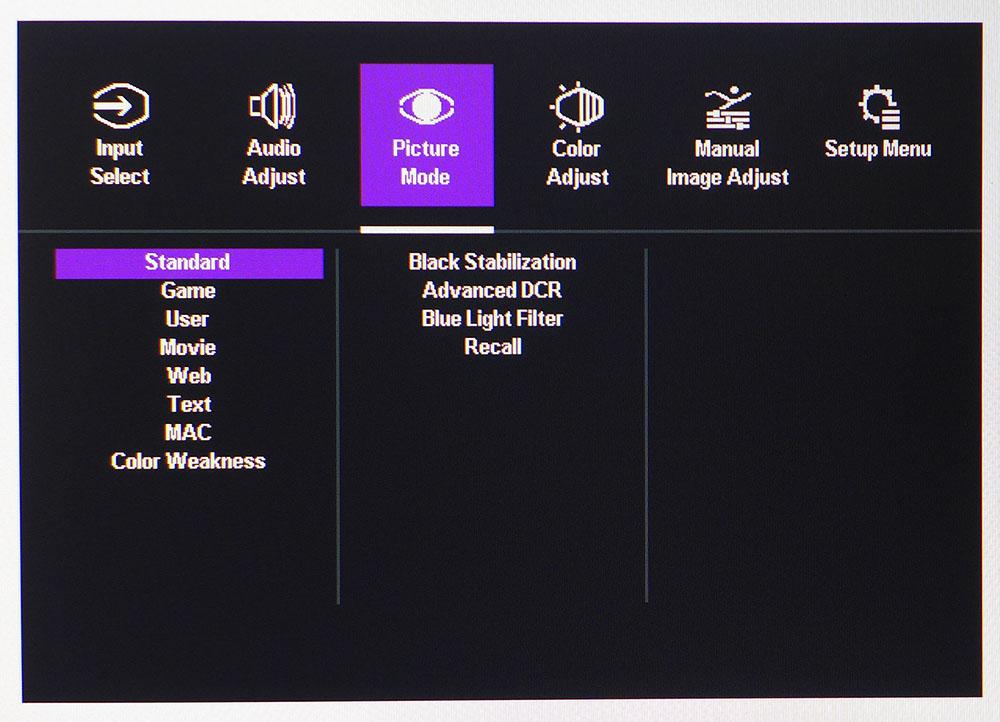

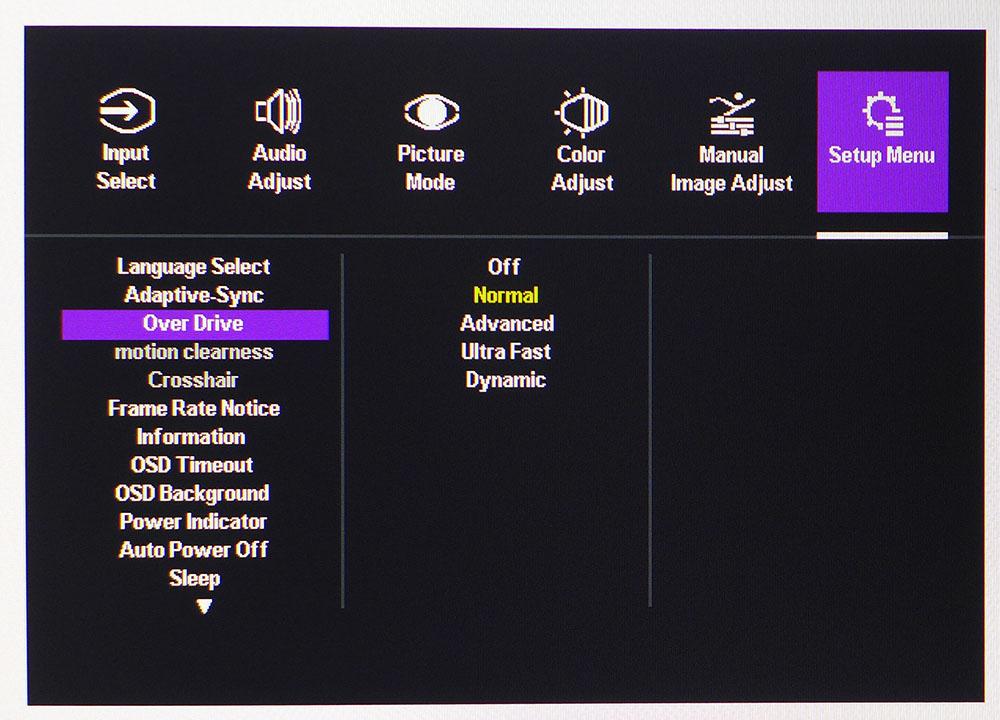
The OSD packs a lot into just a few sub-menus. There are eight task-specific picture modes, including one for users needing compensation for color blindness. Each mode has different options like a black stabilizer to control the black level, dynamic contrast and a blue light filter. Standard is the best mode because it opens up all the image controls.
Color Adjust has many things not commonly seen outside the professional genre. In addition to color temp and gamma presets, you can select the color gamut. I tested all the presets and found sRGB and DCI-P3 to follow their standards closely, but Adobe RGB and BT.2020 were off the mark. The GM27-FQS is accurate when compared to DCI-P3, but the gamut does not get larger than that.
The gaming options are found in the Setup Menu. A four-level overdrive is included, but settings above Normal cause too much ghosting around moving objects. Motion Clearness is an effective backlight strobe with three levels. You have to turn off Adaptive-Sync, but the strobe does increase motion resolution. The highest level is the smoothest and cuts light output by around 30%.
Cooler Master GM27-FQS Calibration Settings
In the GM27-FQS’ Standard mode, you can go with factory default settings and see good color accuracy with a slightly warm white point. The easiest fix is to select the DCI-P3 color gamut in the Color Space sub-menu. No further calibration is required, and in fact, adjusting the User color temp won’t make any visible improvement. This is a very accurate monitor. I noted that selecting any Color Space options besides Auto locked out the color temp presets. I’ll show you charts from all the different modes on page four. If you want the lowest possible error values, try my settings below.
In HDR mode, you can calibrate grayscale and adjust brightness and contrast if you wish. This is something very few HDR monitors allow. That mode is also pretty accurate and doesn’t require any adjustment for a good image.
| Picture Mode | Standard |
| Brightness 200 nits | 71 |
| Brightness 120 nits | 44 |
| Brightness 100 nits | 36 |
| Brightness 80 nits | 28 |
| Brightness 50 nits | 16 (min. 17 nits) |
| Contrast | 70 |
| Gamma | 2.2 |
| Color Temp User | Red 100, Green 96, Blue 100 |
Gaming and Hands-on
Cooler Master bills the GM27-FQS as a versatile monitor and in that category, it delivers. With 109ppi pixel density, it’s well suited to just about any work task, whether text or graphics-based. It has a bright and colorful image that’s not over-saturated or harsh in any way. The anti-glare layer is tightly fit, which makes the picture very sharp and detailed. Contrast is about average for an IPS panel, but I had no complaints when working in Photoshop, browsing the web or watching video content. There are no built-in speakers, so I had to plug in a pair of headphones to watch YouTube.
HDR has little impact on the Windows desktop and doesn’t add much more to gaming. Color is a bit more saturated which is a good thing, but there is no more contrast than SDR. Blacks are slightly deeper, but some shadow detail is hard to see as a result. The GM27-FQS purposely rides a little dark in its HDR shadow and mid-tone areas to increase perceived contrast. Of the three HDR modes, Movie looked the best. I could increase dark detail by using the Standard mode’s Lightness slider, but this made the image look flat.
Continuing my quest through the blood-soaked worlds of Doom Eternal, I enjoyed the super-saturated red hues that were a bit bolder in their HDR versions. I had to tweak the game’s HDR settings to bring shadow detail out more. This reduced contrast a little, but the alternative is to be more often surprised by enemies lurking in dark spaces.
Video processing is nicely implemented here. The GM27-FQS is one of the quicker 165 Hz screens I’ve tested, and it showed in a higher frag count when I played Doom Eternal’s horde mode. This monitor category is still the king of the price/performance ratio with near-competition level response for a reasonable cost. I could play with equal precision on both FreeSync and G-Sync PCs with frame rates at or near the maximum of 165 fps.
Cooler Master includes a backlight strobe for blur reduction as an alternative to Adaptive-Sync. It is effective at its intended task and doesn’t cut light output too much. I only needed the Low setting to achieve smoother motion with almost no cost in brightness. I saw a few frame tears with AS turned off, but the strobe is a viable and useful feature for those who prefer it. The overdrive is also effective on its lowest setting of the four available. Higher options caused visible ghosting which reduced motion resolution. The GM27-FQS is indeed a versatile monitor that serves well for work, gaming or entertainment.
Current page: Features and Specifications
Next Page Response, Input Lag, Viewing Angles and Uniformity
Christian Eberle is a Contributing Editor for Tom's Hardware US. He's a veteran reviewer of A/V equipment, specializing in monitors. Christian began his obsession with tech when he built his first PC in 1991, a 286 running DOS 3.0 at a blazing 12MHz. In 2006, he undertook training from the Imaging Science Foundation in video calibration and testing and thus started a passion for precise imaging that persists to this day. He is also a professional musician with a degree from the New England Conservatory as a classical bassoonist which he used to good effect as a performer with the West Point Army Band from 1987 to 2013. He enjoys watching movies and listening to high-end audio in his custom-built home theater and can be seen riding trails near his home on a race-ready ICE VTX recumbent trike. Christian enjoys the endless summer in Florida where he lives with his wife and Chihuahua and plays with orchestras around the state.
-
husker A monitor stand should not extend so far in front of the screen as to get in the way of the workspace, no excuses.Reply -
hotaru251 even 400 nit is basically "no different" in HDR....why would you list 300nit as hdr x_x...Reply -
Friesiansam How much cheaper would this monitor be, without the fairy lights and overdesigned stand?Reply